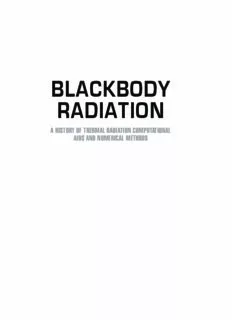Table Of ContentBLACKBODY
RADIATION
A HISTORY OF THERMAL RADIATION COMPUTATIONAL
AIDS AND NUMERICAL METHODS
Optical Sciences and Applications of Light
Series Editor
James C. Wyant
University of Arizona
Nanofabrication: Principles to Laboratory Practice, Andrew Sarangan
Blackbody Radiation: A History of Thermal Radiation Computational Aids
and Numerical Methods, Sean M. Stewart and R. Barry Johnson
High-Speed 3D Imaging with Digital Fringe Projection Techniques,
Song Zhang
Introduction to Optical Metrology, Rajpal S. Sirohi
Charged Particle Optics Theory: An Introduction, Timothy R. Groves
Nonlinear Optics: Principles and Applications, Karsten Rottwitt and
Peter Tidemand-Lichtenberg
Photonics Modelling and Design, Slawomir Sujecki
Numerical Methods in Photonics, Andrei V. Lavrinenko, Jesper Lægsgaard,
Niels Gregersen, Frank Schmidt, and Thomas Søndergaard
Please visit our website www.crcpress.com for a full list of titles
BLACKBODY
RADIATION
A HISTORY OF THERMAL RADIATION COMPUTATIONAL
AIDS AND NUMERICAL METHODS
Seán M. Stewart • R. Barry Johnson
Boca Raton London New York
CRC Press is an imprint of the
Taylor & Francis Group, an informa business
CRC Press
Taylor & Francis Group
6000 Broken Sound Parkway NW, Suite 300
Boca Raton, FL 33487-2742
© 2017 by Taylor & Francis Group, LLC
CRC Press is an imprint of Taylor & Francis Group, an Informa business
No claim to original U.S. Government works
Printed on acid-free paper
Version Date: 20160714
International Standard Book Number-13: 978-1-4822-6312-1 (Hardback)
This book contains information obtained from authentic and highly regarded sources. Reasonable
efforts have been made to publish reliable data and information, but the author and publisher cannot
assume responsibility for the validity of all materials or the consequences of their use. The authors and
publishers have attempted to trace the copyright holders of all material reproduced in this publication
and apologize to copyright holders if permission to publish in this form has not been obtained. If any
copyright material has not been acknowledged please write and let us know so we may rectify in any
future reprint.
Except as permitted under U.S. Copyright Law, no part of this book may be reprinted, reproduced,
transmitted, or utilized in any form by any electronic, mechanical, or other means, now known or
hereafter invented, including photocopying, microfilming, and recording, or in any information stor-
age or retrieval system, without written permission from the publishers.
For permission to photocopy or use material electronically from this work, please access www.copy-
right.com (http://www.copyright.com/) or contact the Copyright Clearance Center, Inc. (CCC), 222
Rosewood Drive, Danvers, MA 01923, 978-750-8400. CCC is a not-for-profit organization that pro-
vides licenses and registration for a variety of users. For organizations that have been granted a photo-
copy license by the CCC, a separate system of payment has been arranged.
Trademark Notice: Product or corporate names may be trademarks or registered trademarks, and are
used only for identification and explanation without intent to infringe.
Visit the Taylor & Francis Web site at
http://www.taylorandfrancis.com
and the CRC Press Web site at
http://www.crcpress.com
Dedication
To those scientists and engineers, immortalized in this work, whose tireless
investigations into blackbody radiation created the beginnings of quantum physics;
and
to Donald and Cathy Stewart, loving parents,
and Marianne F. Johnson, loving wife,
for their unceasing support and encouragement.
A computer who must make many difficult calculations usually
has a book of tables...or a slide rule, close at hand.
Maurice L. Hartung writing in 1960 in the preface
to “How to Use Log Log Slide Rules.”
The spectral density of black body radiation ... represents
something absolute, and since the search for the absolutes
has always appeared to me to be the highest form of research,
I applied myself vigorously to its solution.
-Max Planck
In Michael Dudley Sturge, Statistical and Thermal Physics (2003), 201.
Contents
Preface........................................................................................................xiii
List of Figures...........................................................................................xxiii
List of Tables...........................................................................................xxvii
Authors.....................................................................................................xxix
SECTION I The blackbody problem
Chapter 1 Thermal radiation and the blackbody problem.....................3
1.1 Towards a solution to the blackbody problem...............4
1.2 Planck and the blackbody problem................................9
1.3 The work of the experimentalists.................................12
1.4 Thermal laws from dimensional analysis......................16
1.5 Transition and new beginnings....................................26
SECTION II Theoretical and numerical matters
Chapter 2 Theoretical developments.....................................................33
2.1 Spectral representations...............................................33
2.2 Two important special functions..................................36
2.2.1 Polylogarithms..................................................36
2.2.2 The Lambert W function.................................39
2.3 Two common spectral scales used to represent
blackbody radiation.....................................................41
2.4 Other spectral scale representations.............................46
2.5 Ephemeral spectral peaks............................................52
2.6 Logarithmic spectral scales..........................................57
2.7 The radiometric and actinometric cases.......................58
2.8 Normalized spectral exitance.......................................61
2.9 The Stefan–Boltzmann law..........................................62
2.9.1 The traditional approach..................................63
2.9.2 A polylogarithmic approach.............................66
2.10 Fractional functions of the first kind............................68
2.11 Fractional functions of other kinds..............................73
2.12 Centroid and median wavelengths...............................77
ix
x Contents
2.13 The standard probability distribution and
cumulative probability distribution functions for
blackbody radiation.....................................................83
2.14 Infrared, visible, and ultravioletcomponents in the
spectral distribution of blackbody radiation................86
Chapter 3 Computational and numerical developments.......................97
3.1 Approximations to the spectral exitance.....................97
3.1.1 The laws of Wien and Rayleigh–Jeans.............97
3.1.2 Extended Wien and Rayleigh–Jeans
approximations...............................................100
3.1.3 Polynomial interpolation and logarithmic
correction factors............................................101
3.1.4 Laurent polynomials and non-rational
approximations of Erminy..............................103
3.2 Computation of the fractional function of the first
kind............................................................................107
3.2.1 Series expansion methods...............................108
3.2.1.1 Large arguments..............................108
3.2.1.2 Small arguments..............................114
3.2.1.3 Division point..................................116
3.2.2 Approximation of the integrand first..............118
3.2.3 Gauss–Laguerreand generalised
Gauss–Laguerrequadrature............................119
3.2.4 Asymptotic expansion....................................123
3.2.5 Other methods................................................126
Chapter 4 Blackbody sources and basic radiometry...........................131
4.1 Blackbody sources......................................................131
4.2 Goniometric characteristics of surfaces......................133
4.3 Inverse square law......................................................137
4.4 Extended source radiometry......................................139
4.5 Radiometry of images................................................143
4.6 Example problem.......................................................152
SECTION III Computational aids
Chapter 5 Nomograms and graphs used for thermal radiation
calculations........................................................................157
5.1 Nomograms................................................................157
5.2 Graphs.......................................................................170
5.3 The legacy of graphical aids.......................................180
Description:Shelving Guide: Electrical Engineering In 1900 the great German theoretical physicist Max Planck formulated a correct mathematical description of blackbody radiation. Today, understanding the behavior of a blackbody is of importance to many fields including thermal and infrared systems engineering,

